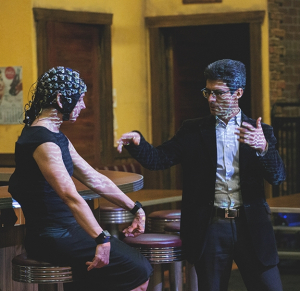Contreras-Vidal seeks to answer what happens in the brain as people create and enjoy art
Bringing together scientific research and artistic inquiry is a serious mission for the D.C. Art Science Evening Rendezvous (DASER). It offers monthly conversations about different interdisciplinary topics with invited speakers from all over America.
The September event, which is a collaboration between DASER and the Building Reliable Advancements in Neurotechnology (BRAIN) Center at the University of Houston’s Cullen College of Engineering, explores the topic of art and the human brain.
DASER is co-sponsored by the Cultural Programs of the National Academy of Sciences (CPNAS) and Leonardo, the International Society for the Arts, Sciences and Technology.
The idea for the topic and the collaboration came about at the 2017 International Conference on Mobile Brain-Body Imaging and the Neuroscience of Art, Innovation and Creativity where J.D. Talasek, director of CPNAS met UH’s Jose Contreras-Vidal, director of the BRAIN Center.
“We wanted to not only continue the conversation, but expand on it,” said Talasek, who will moderate the discussion.
Contreras-Vidal, Hugh Roy and Lillie Cranz Cullen Distinguished Professor of electrical and computer engineering at the Cullen College, will give the opening remarks for the evening. The professor is conducting groundbreaking research at the intersection of the arts and neuroscience.
With funding from the National Science Foundation, Contreras-Vidal studies what happens inside of the brain as individuals create and contemplate art. In connection with this ongoing “Brain on Art” research, Contreras-Vidal and his team recorded the brain waves of various artists – visual artists, chefs, dancers and musicians – while they created and performed to understand unique brain activity. His team has also peered into the minds of museum-goers while they viewed art exhibits and children while they played the popular computer game “Minecraft.”
“SciArt innovations emerging from the “Brain on Art” research, such as engineered precision art therapy and noninvasive neurodiagnostics and neurotherapeutics, could one day help individuals with brain injury, neurological disorders, and other disabilities move, heal and feel again,” said Contreras-Vidal.
Speakers for the evening include: Dania Gutierrez, lead researcher of the Biomedical Signal Processing Laboratory and associate professor of the Center for Research and Advanced Studies in Mexico; Norberto Grzywacz, professor of neuroscience and physics and dean of the Graduate School of Arts & Sciences at Georgetown University; Juliet King, associate professor of art therapy at George Washington University and adjunct associate professor in the department of neurology at the Indiana University School of Medicine; and Zachary Wallmark, assistant professor of musicology and director of MuSci Lab at Southern Methodist University.
A Livestream webcast will be available for registrants who can’t make it to the D.C. event.
When: The “Art and the Brain” forum is Thursday, September 20, 2018.
Where: Keck Center, 500 Fifth St., N.W., Room 100
Cost: Free. Registration and photo ID required.
For more Information: Visit the website of D.C. Art Science Evening Rendezvous (DASER) at http://www.cpnas.org/events/daser-092018.html
